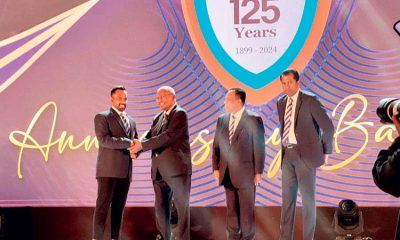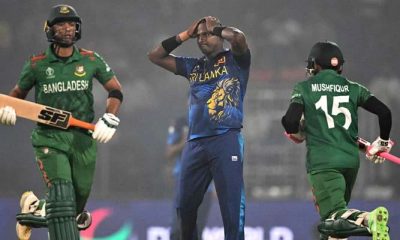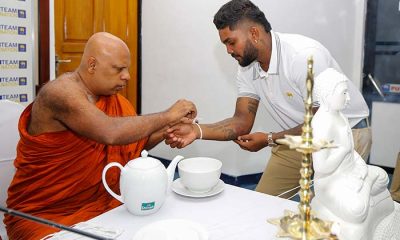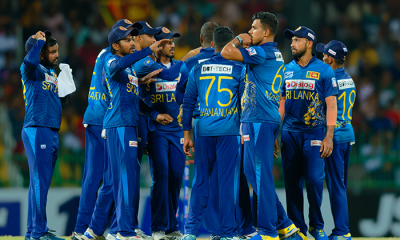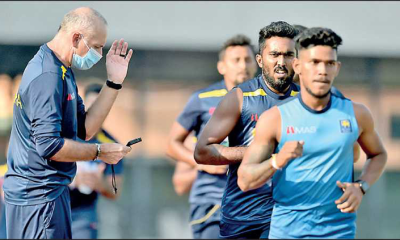Sports
How two World Cup tickets changed cricket’s power bases
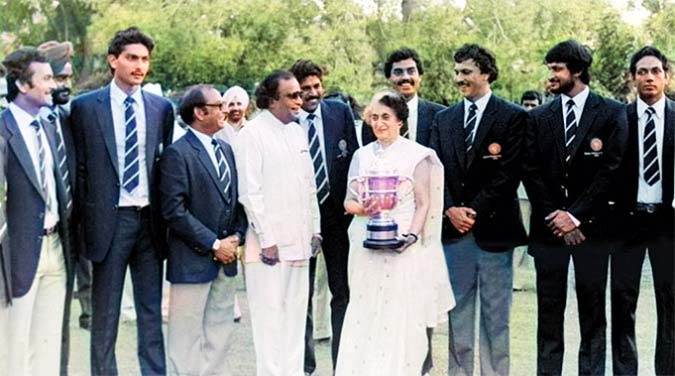
Rex Clementine
in Delhi
Literally, nobody expected India to reach the finals of the 1983 World Cup, leave alone winning it. In the previous edition of the tournament – in 1979 – they had even lost a game to Sri Lanka, who were yet to get Test status. But suddenly when Kapil Dev’s team entered the finals, the team had not only reached a new high but a stage was set to change the power bases of cricket too, rather accidentally.
India’s Minister of Education Siddhartha Shankar Ray is on a state visit to the UK. He approaches Indian Cricket Board President N.K.P. Salve, who was also a Cabinet Minister, to ask whether he could get two tickets for the game.
Those days ICC was run by MCC with Lord’s being the headquarters of the sport and MCC President becoming the ICC President automatically.
MCC turns down Salve’s request for two tickets for the final. The Indian board chief finds out that seats at the pavilion reserved for MCC members are empty. Obviously, MCC members aren’t interested in attending a game where England aren’t playing.
Once India create an upset by beating defending champions West Indies in the final, Salve returns home a determined man. He wants to move the next World Cup out of England. But that’s going to be a gigantic task.
Back in India, he calls for a meeting involving other regional heads of cricket such as Gamini Dissanayake and Nuzki Mohammad from Sri Lanka, Air Marshall Noor Khan from Pakistan and so on.
There they agree that the next World Cup should be held in Asia. Salve approaches Indian Prime Minister Indira Gandhi and relates his ambitious plans. He confides that he will struggle to get the finances to host such a mega event.
Mrs. Gandhi, the iron lady, promises him a blank cheque. Salve can go ahead with his plans for the World Cup. So how does she do it? She calls up business tycoon Dhirubhai Ambani, the founder of Reliance Group and father of Mukesh Ambani. The blank cheque is guaranteed.
When the matter is taken to ICC, England are furious and are determined not to let go of the sport’s showpiece event. But Salve had done his homework and played his cards smartly. He had come to a deal with Australia that they would get the chance to host the next World Cup in 1992. Australia agree provided there’s a secret ballot and not an open ballot.
Having brought the World Cup to Asia, Salve’s next move is to make sure there is a fair playing field for all cricketing nations, and he works rigorously to rid founding members of the ICC their veto powers.
This he does by promising member boards equal share of revenues and very soon, England and Australia lose their veto power.
Until very recently, the Indian board worked hand in hand with regional allies. But once they had total power, they wanted to do it solo. What has happened to the Asian solidarity? This is the first World Cup being held in Asia in one country. Always it used to be a joint effort.
Easily, India could have given Sri Lanka half their games to be held in Colombo and let Pakistan and Bangladesh play some of their games in Lahore and Dhaka. You can only wish sanity prevails.
Nobody has complained openly for everyone fears the Indian board. But you can see there are murmurs.
World cricket owes much to N. Salve for breaking England’s clout in the game. A chartered accountant from Nagpur. His parents were both freedom fighters and you can sense from where he got the guts to take on the establishment.
As for Mrs. Gandhi, sadly a year after giving the greenlight for the World Cup to be brought to Asia, she is gunned down by her own security guards. ‘Operation Blue Star’ that she had authorized to take the Sikh militants down, didn’t go down too well with the Sikhs. The military operation was a success, but in the process the forces desecrated the Golden Temple in Amritsar, the Sikhs’ holiest shrine.
As for Sri Lanka, they have been India’s closest ally. Australia once tried to diminish India’s power base by getting former Prime Minister John Howard as the President of the ICC. Howard had agreed to come on board on one condition. That was to get elected uncontested.
India did not object. They just kept quiet. Instead, they used Sri Lanka as a cat’s paw to object to Howard becoming the cricket boss. Sri Lanka’s objections were flimsy. But Maitland Place doesn’t care. All what they want is India to come to Colombo once in two years and play five ODIs and their cricket is set for a few years. And that’s the way the cookie crumbles!
Latest News
IPL 2025: Kohli and Hazlewood break Royal Challengers Bengaluru’s home duck as Rajahstan Royals botch another chase

At some point, you’d think the toss gods would show Royal Challengers Bengaluru (RCB) a little mercy at home. But once again, the coin turned its back on Rajat Patidar. This time, though, the bad luck ended right there as they posted 205 for 5, their highest total at home this season. For all that, another heartbreak loomed, but RCB turned it around sensationally to clinch their first home win – and perhaps their most dramatic win at any venue – of IPL 2025.
The losing side were Rajasthan Royals (RR), who came into this contest having let back-to-back games slip out of their control in the final over. Their tension seemed to have defused when Dhruv Jurel , having scratched his way to 18 off 23, found his hitting range, and when he and Shubnam Dubey ransacked 22 off Bhuvneshwar Kumar in the 18th over, the equation came down to 18 off 12.
Then came Josh Hazelwood. He was ice-cold in the moment, producing a masterful 19th over of unhittably steep bounce – conceding just one run and taking two wickets, of Jurel and Jofra Archer in successive balls.
It was left to Yash Dayal, the same man who had held his nerve in a now-legendary last over to deliver their previous home win, against Chennai Super Kings last season. And he delivered as RR lost by 11 runs after having the chase in their grasp for so long.
The M Chinnaswamy Stadium erupted. RCB had finally found their voice at home and, with it, a long-overdue win that put them in the top three. For RR, this was a fifth straight loss that left them on the brink.
With 17 needed off ten, Hazlewood conjured a moment of magic – a pinpoint wide yorker that Dhruv Jurel shaped to scythe but appeared to miss. With little conviction, Patidar opted for a caught-behind review. Technology confirmed what only Jurel might have known – a faint under edge that carried low to Jitesh Sharma. A seemingly innocuous dot turned into a game-changing strike.
Jurel, who had weathered a slow start and was just beginning to ignite, walked back, and with him went RR’s best hope. But Hazlewood wasn’t done. He cranked up a hard-length ball next that cramped Archer for room. It was as if Archer had been served a dish of his own, cold. The ball ballooned to cover, where Patidar pouched it gleefully.
If Hazlewood’s final over, the 19th, was theatre, his penultimate over was no less telling. Having seen balls angled across the left-handers disappear, he went around the wicket to Shimron Hetmyer and pounded the surface with venom. Hetmyer tried to nudge him away but only managed a feather of an inside edge through to Jitesh. Only six runs came off that over, the 17th, and RCB’s grip got firm.
Long before the chaos of the death overs, RR were cruising. Yzshaswi Jaiswal had lit the Chinnaswamy up with a power-packed 49 off 19, and Nitish Rana was stroking it with finesse. At 110 for 2 in nine overs, the chase seemed to be on autopilot.
It’s here that Krunal Pandya was summoned and he delivered a breakthrough first ball when Riyan Parag, looking to muscle a slog sweep, only managed a top edge that settled into Jitesh’s gloves.
At the other end, Suryash Sharma was equally impressive. Mixing up quick, skiddy legbreaks with the odd wrong’un, he kept the pressure on. RR managed just one boundary from the tenth to the 13th overs. Under rising pressure, Rana went for a release shot in the 14th, only for Bhuvneshwar to pluck a catch on the second attempt at short fine leg. Krunal now had figures of 3-0-19-2. The strangle was on.
Half-centuries from Virat Kohli and Devdutt Padikkal laid a strong foundation after Phil Salt’s scratchy 26 off 23, while a late dash from Tim David and Jitesh lifted RCB to 205 for 5. Kohli overcame a streaky start to get to a composed fifty in 32 balls. His early duel with a fiery Archer was, in particular, thrilling. Meanwhile, Padikkal made the most of two dropped chances to notch up a second straight half-century.
Just as the platform was set for a lift-off, RR struck back, removing Kohli, Padikkal, and Patidar in quick succession. But David and Jitesh picked up 42 runs in just 19 balls to cap the innings with a flourish. In a match that swung wildly from one side to the other, those closing overs turned out to be the difference between a defendable total and yet another heartbreak.
Brief scores:
Royal Challengers Bengaluru 205 for 5 in 20 overs (Phil Salt 26, Virat Kohli 70, Devudutt Padikkal 50, Tim David 23, Jitesh Sharma 20*; Jofra Archer 1-33, Sandeep Sharma 2-45, Wanidu Hasaranga 1-30) beat Rajasthan Royals 194 for 9 in 20 overs (Yashaswi Jaiswal 49, Vaibhav Suriyavanshi 16, Nitish Rana 28, Riyan Parag 22, Dhruv Jurel 47, Shimron Hetmyer 11, Shubham Dubey 12; Josh Hazlewood 4-33, Bhuveneshwar Kumar 1-50, Yash Dayal 1-33, Krunal Pandya 2-31) by 11 runs
[Cricinfo]
Sports
Dialog renews commitment to school rugby in 2025

Dialog Axiata PLC, Sri Lanka’s leading connectivity provider and long-standing patron of school sports, has reaffirmed its commitment to youth development by once again partnering with the Sri Lanka Schools Rugby Football Association (SLSRFA) to power the 2025 Under-19 School Rugby Season.
In a break from tradition, this year’s tournament will begin with the prestigious President’s Trophy Knock-Out Tournament, which kicks off on 25th April, featuring sixteen top rugby-playing schools. The League Tournament will follow, drawing over 2,500 players from 90 schools, making it one of the largest school sporting events in the country.
The 2025 season promises a festival of school rugby, spread across premier venues in Colombo. The Knock-Out Tournament will spotlight the best young talent Sri Lanka has to offer, culminating in a grand finale on 18th May at Sugathadasa Stadium.
Opening day fixtures on 25th April will see Wesley College take on St. Joseph’s College at Royal Grounds, while Dharmaraja College meets D.S. Senanayake College at CR&FC Grounds. Both matches begin at 4:15 PM.
A blockbuster Saturday awaits on 26th April, with four matches lined up. At CR&FC Grounds, S. Thomas’ College face Science College at 3:30 PM, followed by Trinity College vs. St. Anthony’s College at 6:30 PM. Simultaneously, two more games kick off at 4:15 PM — Zahira College vs. Vidyartha College at Havelock Grounds and Sri Sumangala versus defending champions Isipathana College at Royal Grounds.
The opening weekend concludes on 27th April, with St. Peter’s College versus Thurstan College at Royal Grounds and Royal College versus Kingswood College at CR&FC Grounds, both kicking off at 4:15 PM.
The quarter-finals will be held on 3rd and 4th May, followed by semi-finals on 9th and 11th May, with the season climaxing in the final at Sugathadasa Stadium.
As the principal sponsor, Dialog Axiata has ensured comprehensive coverage of the tournament. All matches will be broadcast live on Dialog Television via ThePapare TV (Channels 62 & 63) and ThePapare TV HD (Channels 126 & 127). Fans can also tune in via Dialog ViU and ThePapare.com, enabling students, alumni, parents, and supporters to follow the action from anywhere.
At the official sponsorship handover Lasantha Theverapperuma, Group Chief Marketing Officer of Dialog Axiata PLC, presented the sponsorship cheque to Kamal Ariyasinghe, President of the SLSRFA and Additional Secretary of the Ministry of Education. Also in attendance were Harsha Samaranayake (Vice President – Brand & Media, Dialog Axiata) and SLSRFA officials Chanaka Dhananjaya (Treasurer), Manuja Nimmana (Secretary) and Nirodha Wijerama (Tournament Secretary).
Sports
Harsha requests for Sports Ministry and Sri Lanka Athletics mediation to take part in Indian Grand Prix

Reigning national champion in the men’s 800 metres, Harsha Karunaratne has requested Sri Lanka Athletics and the Ministry of Sports to provide him with the opportunity to compete in the upcoming Indian Grand Prix 2 utilizing his own funds in a bid to produce a top performance.
Sri Lanka Athletics did not pick Karunaratne for the South Asian Athletics Championship which has now been postponed after being placed second at the selection trial. He had competed within a week after recovering from an illness. His non selection sparked controversy prompting his coach Susantha Fernando to vehemently criticize the track and field governing body.
G.K. Chathuranga who won the event at the selection trial held early last month and second placed Karunaratne were separated only by milliseconds. While Chathuranga returned a time of 1:49.89 seconds, Karunaratne clocked 1:49.98 seconds.
In his letter addressed to the Sports Minister, the Director of Sports and Sri Lanka Athletics Karunaratne requests the authorities to mediate on his behalf to take part in the Indian Grand Prix 2 taking place in Thrivendram, India on May 17.Karunaratne has stated that he has no opportunity in Sri Lanka now to prove that he has the ability to produce a better timing. “
“I am confident that I have the ability to run below 1:48.00. But there is no opportunity for me to produce such a feat here in SriLanka,” states Karunaratne in his letter. “I am greatfull to you if you could provide me with the opportunity. I am ready to bear the full cost.”
Athletes need the approval of the governing body of the sport of their country to take part in such events
. The country’s top athletes receive Sri Lanka Athletics mediation to take part in overseas competitions. . Taking part in such competetive events has stood in good stead for a number of athletes to improve their rankings.
The former Ratnayake Central Walala athlete is the elder brother of Asian Games gold medallist Tharushi Karunaratne. Like his sister, Harsha too excelled at international competitions when he was a youth athlete.He won a silver medal in the 800 metres at the Asian Youth Championships in Bangkok in 2017 before emerging as a top national athlete.
by Reemus Fernando
-

 Business7 days ago
Business7 days agoDIMO pioneers major fleet expansion with Tata SIGNA Prime Movers for ILM
-

 News6 days ago
News6 days agoFamily discovers rare species thought to be extinct for over a century in home garden
-

 Features4 days ago
Features4 days agoRuGoesWild: Taking science into the wild — and into the hearts of Sri Lankans
-

 Foreign News6 days ago
Foreign News6 days agoChina races robots against humans in Beijing half marathon
-

 Editorial7 days ago
Editorial7 days agoSelective use of PTA
-
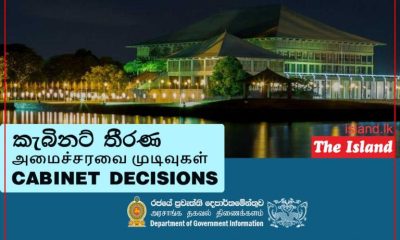
 News3 days ago
News3 days agoOrders under the provisions of the Prevention of Corruptions Act No. 9 of 2023 for concurrence of parliament
-

 Features5 days ago
Features5 days agoNew species of Bronzeback snake, discovered in Sri Lanka
-

 Features6 days ago
Features6 days agoThe ironies of history



